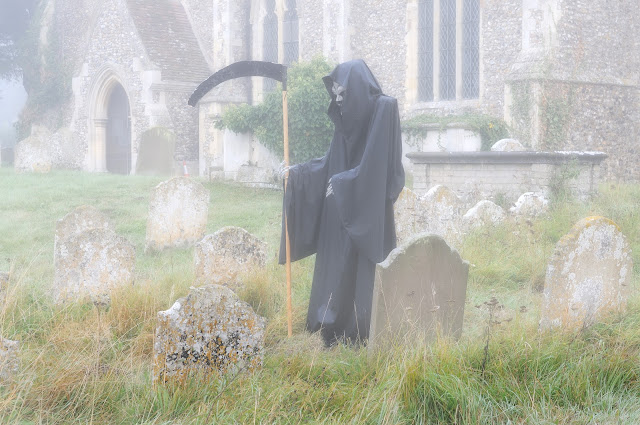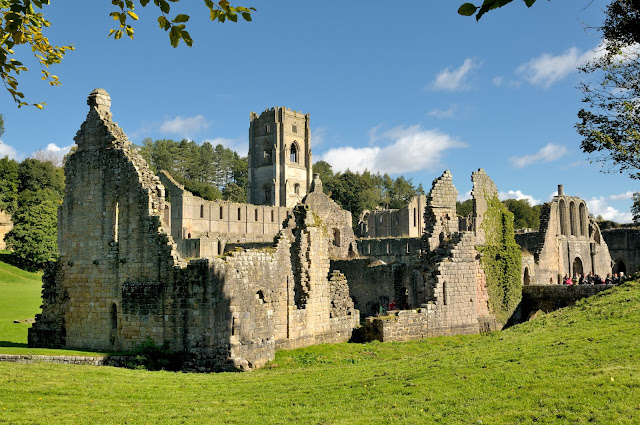Our last place to visit with Gra and Jane was Ripon, not far from our holiday home High Oak, near Pickhill.
The doorways in the West end - and I missed the splendid Gothic façade
I took very few images, which in hindsight was a mistake - I have learnt in the last few years what a wealth of history I have missed. A revisit is needed!
The Cathedral Church of St Peter and St Wilfrid, commonly known as Ripon Cathedral, is a cathedral in the North Yorkshire city of Ripon. Founded as a monastery by Scottish monks in the 660s, it was re-founded as a Benedictine monastery by St Wilfrid in 672
St Wilfrid, who built the stone church, with its still-surviving crypt, died in 710. Only four years later, an account of his life was written by a monk, known to us as Stephen of Ripon. He tells us that this was the first church to be built by Wilfrid, and that the church and its monastic community remained the favourite of all of his foundations. It was to Ripon that his body was brought after his death at Oundle, one of his later monasteries. In order to build it, Wilfrid followed a practice that he had observed in the great basilicas of Rome: he re-used Roman stone and Roman columns, in this case bringing them from the major Roman site of Aldborough (Isurium Brigantum), only a few miles away. The church was dedicated to St Peter, reflecting Wilfrid’s strong commitment to the Roman tradition of Christianity at a time when the Celtic tradition was still strong in Northumbria.
The cathedral is notable architecturally for its gothic west front in the Early English style, considered one of the best of its type, as well as the Geometric east window. The seventh-century crypt of Wilfrid's church is a significant example of early Christian architecture in England.
A new sculpture depicting the Virgin Mary holding the baby Jesus has been bequeathed to the Cathedral by Yorkshire artist and former mining engineer, Malcolm Brocklesby, who died in 2010. The piece, called ‘Madonna of the Cross’, shows the Virgin Mary dedicating her child to God. Her figure is integrated with the cross, but she is looking beyond Calvary to the Resurrection. It is hoped that the sculpture will become a focus for prayer requests. A second version of the sculpture was commissioned by English Heritage for Mount Grace Priory.
Ripon is famed for its misericords, dating from between c.1489 and 1494. Remarkably, despite the severe damage of the Civil War, when the medieval glass was destroyed, the misericords survived intact.
(A misericord (sometimes named mercy seat, like the Biblical object) is a small wooden structure formed on the underside of a folding seat in a church which, when the seat is folded up, is intended to act as a shelf to support a person in a partially standing position during long periods of prayer)
Three hands can be detected in these masterpieces of the carvers’ art, and very unusually, for a period when carvers are commonly anonymous, it has been possible to determine that they were created by the workshop of the Bromflet family, known in the Ripon historical record along with other named local carvers from around this date. With characters in the dress of the time, they present moralistic scenes, mythological creatures, and some biblical and doctrinal episodes, with extraordinary vigour and power.

Wilfrid’s crypt reflects the ecclesiastical structures that he had seen on his travels to Rome and in Rome itself, no doubt also including the few catacombs that were accessible in the seventh century. We know that on his first visit, in c.655-56, he spent many months in devotion at the shrines of saints. By the time the crypt was built he had also spent a considerable amount of time in Gaul, which likewise had underground chambers for saints’ relics in some of the major churches. The crypt was built within an excavated pit, and then the upper church was built above, covering a larger area. Although the church and the crypt were connected by the entrance and exit passages, they were not structurally related: the crypt was not load-bearing and was a complete structure within itself. It is this structural integrity and independence that has allowed the crypt to survive intact, despite the various sequences of destruction and rebuilding that have taken place above ground.



























































